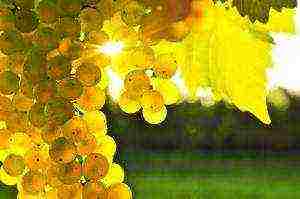Content [show]
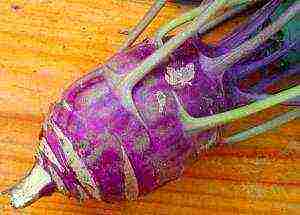 Kohlrabi is a type of cabbage, a feature of which is a stem-grower, which has a rounded shape. It has a delicate sweetish taste and is used for making salads, side dishes, casseroles. In addition to its taste, kohlrabi cabbage is rich in vitamins and minerals. And the low calorie content makes the vegetable a valuable product in the diet. How to grow kohlrabi cabbage outdoors?
Kohlrabi is a type of cabbage, a feature of which is a stem-grower, which has a rounded shape. It has a delicate sweetish taste and is used for making salads, side dishes, casseroles. In addition to its taste, kohlrabi cabbage is rich in vitamins and minerals. And the low calorie content makes the vegetable a valuable product in the diet. How to grow kohlrabi cabbage outdoors?
Description and photo of kohlrabi cabbage
 Outwardly, the stem plant resembles a turnip, it tastes similar to a cabbage stump from a white cabbage. But much softer and juicier. It is important to harvest on time, without waiting for overripe and coarse fibers. Kohlrabi cabbage most often comes in various colors: pale green, yellow, purple, pink. The flesh of the stalk is always white or light beige. The shape of the stalk, depending on the variety, can be round, oblong or flattened, like a turnip. Vegetable size can range from 0.2 to 1 kg. In the photo, kohlrabi cabbage of different varieties.
Outwardly, the stem plant resembles a turnip, it tastes similar to a cabbage stump from a white cabbage. But much softer and juicier. It is important to harvest on time, without waiting for overripe and coarse fibers. Kohlrabi cabbage most often comes in various colors: pale green, yellow, purple, pink. The flesh of the stalk is always white or light beige. The shape of the stalk, depending on the variety, can be round, oblong or flattened, like a turnip. Vegetable size can range from 0.2 to 1 kg. In the photo, kohlrabi cabbage of different varieties.
Early varieties of kohlrabi cabbage allow you to harvest several times per season, but they are unsuitable for long-term storage and require immediate processing. Late varieties, with a competent approach, can delight with their taste all winter. For this, the stems are sprinkled with moistened sand and placed in the basement.

Growing kohlrabi cabbage from seeds for seedlings
To get an early harvest, seedlings are grown on windowsills. This method allows you to get stem fruits already at the beginning of summer. The cultivation of kohlrabi cabbage from seeds for seedlings is carried out in mid-March. It is important to prepare planting material in order to reduce the risk of diseases such as powdery mildew, black leg, various fungal infections.
How to process planting material:
- You need to place the seeds in a cloth and hold them in hot water at 50-60 degrees for half an hour.
- Refrigerate for 10 minutes in cold water.
- Leave for 12 hours for the seeds to swell in a room at room temperature.
- Place in the refrigerator for a day.
- For flowability, the seeds can be dried a little by holding them in the air.
Sowing is carried out in a previously prepared soil, consisting of sand and sod land in a 1: 1 ratio. You can add a little humus and ash. For disinfection, the soil is spilled with a manganese solution (1 g per 10 liters of water). You can grow kohlrabi cabbage from seeds for seedlings directly into individual cups or into boxes with subsequent picking. The second method is better, as it allows you to get stronger and stronger plants.
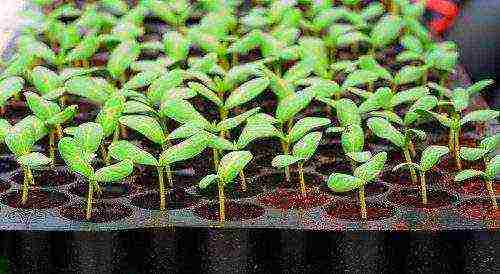
For sowing, grooves are cut in the soil, at a distance of 3-4 cm from each other. The seeds are laid to a depth of 1 cm, the distance between them is maintained 1-2 cm. Sprinkle with loose earth on top and remove the box on the windowsill.When seedlings appear, it is necessary to remove the seedlings to a cooler place with a temperature of 10-15 degrees for several days in order to prevent stretching of the plants. After 2 weeks, you can start picking into individual cups. The stemfruit can be grown both in greenhouses and in the open field.
How to grow kohlrabi cabbage outdoors?
For a later harvest, sowing can be done directly into the ground or in greenhouse nurseries. In this case, the pick is carried out immediately to a permanent place. The technology of how to grow kohlrabi cabbage in the open field for seedlings is no different from the method on the windowsill. Despite the fact that kohlrabi tolerates frost well, when planting early, it is recommended to cover the plants with non-woven material at night.
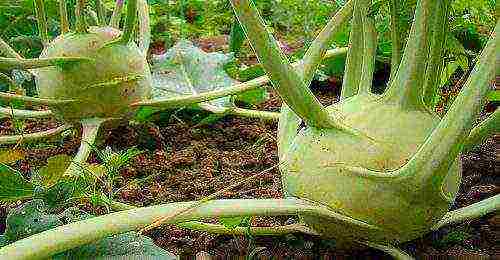
For planting kohlrabi cabbage seedlings, well-lit places with fertile, light soil are suitable. Good predecessors: legumes, potatoes, tomatoes, onions. To avoid diseases and pests, do not plant seedlings after other cruciferous plants. Manure compost can be added to the soil before planting. It is not recommended to apply fresh manure, as it increases the risk of being hit by a fly.
For early varieties, a distance between rows of 30 cm is sufficient, and between plants 25. For mid-ripening and late varieties 40 and 30, respectively. Unlike other types of cabbage, this one does not need to be deepened, since the fruit is formed on the stem.
Caring for kohlrabi cabbage
A week after planting the plant in a permanent place, you can fertilize with nitrogen fertilizer. After 2-3 weeks after it, you can feed with fermented organic matter. And the last make-up is done with a solution of superphosphate with potassium.
Proper care of kohlrabi cabbage includes:
- Regular watering. It is carried out at least once every 3 days.
- Loosening the soil.
- Pest and disease control.
Cabbage especially needs competent watering during the formation of a stem crop. A deficiency can adversely affect formation, and an excess can lead to cracking. It is important to avoid stagnant water while maintaining moderate humidity. To combat pests and diseases, the same means are used as for white cabbage. Loosening takes a special place. It contributes to the saturation of the soil with oxygen. It is important to carry it out carefully so as not to damage the stem and not sprinkle it with soil.

Valuable tips for growing kohlrabi
Many gardeners hesitate to grow kohlrabi and still consider it an overseas vegetable. In fact, agricultural technology is simple and this type of cabbage grows well in our climatic conditions.
Tips for growing kohlrabi:
- To eat from the beginning of summer until the very frost, you need to plant several varieties of different ripening periods. Late ones will last well until February.
- Before planting home seedlings in the ground, you need to harden for several days.
- If there is not enough space for a kohlrabi bed, then it can be planted between other crops as a sealant. She gets along well with almost all neighbors.
- Harvesting is best done earlier, avoiding over-ripening. As soon as the stem grower reaches 7 cm in diameter, it can be eaten.
- Late varieties are less prone to woody stems.
- For storage, the crop is harvested and laid along with the root.
These simple tips for growing kohlrabi will make the process easier and help you get a good harvest of succulent stems.
In the video, useful tips for growing kohlrabi
Turnip cabbage
Kohlrabi cabbage in Latin Brassica oleracea var. gongyoides, in German it sounds like kohlrabi - turnip cabbage, in Italian cavolo rapa - cabbage turnip. In general, the meaning is clear from the name - the edible part of this cabbage is the stembread, which is formed in a two-year-old vegetable in the first year of life. Leaves are wide and wide, but only suitable for feeding rabbits and compost.Flowering begins in the second year of life, but the gardener and gardener no longer observes this, we need to reap the harvest as soon as possible. The homeland of turnip cabbage is the eastern Mediterranean.
Kohlrabi is a valuable vegetable, a champion among cabbages in terms of vitamin C content, behaves well in culinary processing - it is added to soups and salads, you can stew with meat and even make a dessert.
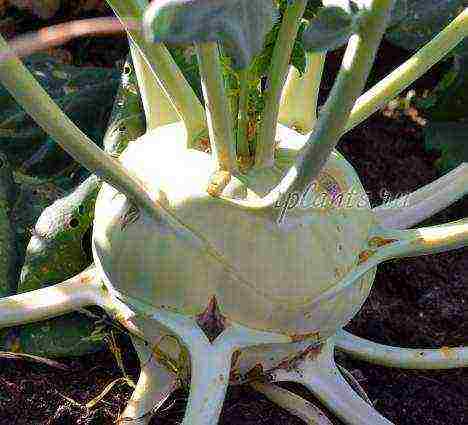
Kohlrabi's place in the garden
Kohlrabi is less demanding than other cabbage on the warmth and nutritional value of the soil. Therefore, it is used in any garden as a compactor of beds - early varieties of kohlrabi can be planted with late-ripening varieties of white cabbage, tomatoes, cucumbers. And you can plant it as a re-culture in the place of leafy greens (spinach, onions on a feather, salads).
Kohlrabi in a crop rotation
In the alternation of crops in the beds, carrots, potatoes, onions, legumes, cereals, cucumbers, and also siderat herbs will be good precursors of kohlrabi.
It is undesirable to plant after any types of cabbage, beets, tomatoes, turnips, radishes, radishes.
In the general crop rotation, kohlrabi should not return to its previous beds earlier than after 4 seasons.
What kohlrabi loves
- Soil acidity 6.5-7.4
- Good soil fertility (light loam)
- Bright sunny place
- Hilling after planting seedlings
- Abundant watering
- Loosening row spacings
- Root and foliar feeding
- Timely pest control measures
Kohlrabi is great for central Russia, as it prefers moderate temperatures and even some coolness, the optimal temperature for growth is 18-24 ° C, but does not like heat when it is above 30 ° C, growth is inhibited, and the stems remain smallish.
All cabbage cultivation can be threatened if you have acidic soils - the keel of cabbage destroys all its species, therefore, soils with an acidity below 6.8-6.5 must be limed.
Kohlrabi landing
Early-ripening varieties are grown in seedlings, and late-ripening ones, which take more than 100-120 days to ripen, are sown with seeds directly into the open ground.

Preparation of seeds for sowing: soak the seeds for 15-20 minutes in hot water (53-55 ° C), then soak in a solution of the drug "Narcissus" diluted at the rate of 5 ml per 1 liter of water. This drug has a growth-stimulating, immunomodulatory, adaptogenic, fungicidal and nematicidal effect.
Sowing is carried out in the first decade of March. Soil: a mixture of universal peat soil, turf soil and coarse sand in equal parts. It is advisable to sterilize the soil in the oven, and with large volumes of plantings by watering potassium permanganate.
To close the seeds to a depth of 1.5-2 cm. It is important to maintain a moderate temperature - not higher than 20 ° C. As soon as shoots appear, to strengthen the seedlings, you need to lower the temperature to 10 ° C for a week, while watering is very moderate, so that the soil is moist, but not very damp, and does not dry out completely. After a week, you need to put the kohlrabi seedlings back in place with a moderate temperature of 18-20 ° C.
Maintaining moderate soil moisture is the most important thing in growing seedlings in cool conditions, at such a temperature, watering is rare, from a spray bottle.
Dive kohlrabi when one real leaf grows - we plant it in separate pots or cups 6-8 cm in diameter, sprinkling with earth until the cotyledon leaves.
The first week after picking, the pots must be left in the same conditions as they grew. When the plants develop 2 leaves, you can apply a spraying with complex fertilizer for vegetables, it is desirable that it contains a rich set of micro and macro elements.
2 weeks before planting the seedlings in the ground, the seedlings should be hardened: they should be taught to the brighter sun and temperature fluctuations - in the daytime 17-18 ° С during the day, at night 9-10 ° С.
Good lighting is also important in caring for seedlings.Kohlrabi is a long-day plant, a long period of illumination accelerates the growth of seedlings, if the weather is very cloudy, the stems stretch out or lean towards the glass - then you need to put additional lighting.
Planting seedlings in open ground
In early May, kohlrabi, at the age of 30-40 days, moves from the window sills of the rooms and the balcony to a permanent place in the garden. By this time, each bush should have 3-4 true leaves.
Pay attention to the weather, it is usually warm in the first ten days of May, but if the spring is cold, you need to wait - if the temperature is low, the kohlrabi will not grow a stem plant, but will give a flower arrow with seeds (critical conditions urge plants to multiply prematurely, and not grow vegetative mass) ...
The distance between the rows when planting kohlrabi is 60 cm, and between the holes - 20 cm.The planting depth is the same or slightly lower than in pots with seedlings. The planted bushes need to be watered and mulched with straw. Shade 2 days from the sun.
Growing kohlrabi from seeds
Late-ripening kohlrabi varieties are not grown in seedlings, but are sown directly in open ground in mid to early June. It is advisable to carry out crops in the beds with carrots or onions. On individual beds, the distance between bushes is calculated as 60 cm between rows and 30 cm between bushes.
Before planting, you need to add humus, or compost, but not fresh manure. For each hole, mix a large handful of humus with the ground.
In May, kohlrabi takes root well, does not suffer from heat, but after germination of seeds, it is necessary to timely thin out the crops.
Caring for kohlrabi cabbage
Kohlrabi is very demanding of the sun (she does not need shading) and fairly abundant watering. To reduce the evaporation of moisture from the soil, it must be mulched. After each watering, you need to loosen the soil between the bushes.
As for top dressing, if the soil is nutritious, it was well filled with compost, then you can completely do without top dressing, especially since the early varieties of kohlrabi grow quickly and quickly end up on the table. Or, limit yourself to dusting the soil under the bushes with wood ash (1 glass per 1 square meter), this at the same time will help protect against pests.
If your site is on poor loamy sandy soils, then with any method of cultivation (when planting seedlings or sowing in the ground), even before planting cabbage, you need to add 1 sq. m of land 25-30 g of ammonium nitrate, 25-30 g of superphosphate and 20-25 g of potassium salt. If your site is on peat soils, the need for potassium increases, add 25-30 g of ammonium nitrate, 25-30 g of superphosphate and 50 g of potassium salt per 1 sq. m of land. If you did not have time to improve the soil, dilute all the components in 10 liters of water and water the cabbage bushes a week after planting the seedlings.
20 days after planting the seedlings, the cabbage must be hilled, then after 10-15 days, the hilling must be repeated. Late kohlrabi, sown in the ground, also needs to be hilled as it grows.
When to harvest
The most delicious, soft and juicy fruits are only six to eight centimeters in diameter. But, of course, it is still a pity to cut such babies, but the maximum that can be allowed is to grow up to 9-10 cm in diameter. Further cultivation leads to lignification of the stalk, and wood cannot be eaten.
Do not try to be guided by the color of the stem, it does not determine its maturity. But the sizes indicated on the package with seeds are a good guideline, because there are varieties of medium-sized stem tubers (350-500 g) and large varieties (up to 2 kg).
Kohlrabi varieties
Kohlrabi differ in different varieties in the shape of the stump: round, spit-round or ovoid, and in color: from cream or white-green to purple (in shades). The pulp even of colored stems is white.
All varieties are conventionally divided into early maturing (usually, but not necessarily, white) and late, usually purple.Early white varieties are much tastier and juicier, but if you are late with harvesting by a day or two or not water it on time, they outgrow or lose their taste - they become fibrous and unsuitable for food. Autumn fruits grow larger, while they outgrow less often, but they have less sugar content and more dietary fiber.
Early varieties
- Hybrid Hummingbird F1 - early maturing (70 days), high taste, poor keeping quality, relatively drought-resistant, medium resistance to overgrowth.
- Vienna White 1350 (selection Aelita) - early ripening (65-75 days), heat-resistant and drought-resistant, strongly affected by cabbage keel, good taste, tends to grow quickly (coarse), poor keeping quality.
- Vitalina (‘Euro-seeds’) - early ripe, round stem, dark purple, weighing 400-430 g, good taste, not for storage, prone to overgrowing.
- Vienna blue - early ripening (70-75 days), heat-resistant and drought-resistant, strongly affected by cabbage keel, good taste, resistance to growth is average, keeping quality is average.
- Idea (‘Euro-seeds’) - early ripe, light green stem fruit, weighing 750-900 g, good and excellent taste. Not for storage, prone to overgrowth.
- Moravia is a Czech variety, a very early variety of very high taste, rather cold-resistant, but poor keeping quality, prone to overgrowth.
- Early Knauf - very early ripening, good taste, fairly cold-resistant, average keeping quality, prone to overgrowth.
- Smak is an early-ripening variety, dark purple with high palatability, absolutely not stored, the tendency to overgrowth is average.
- Piquant (‘Agrofirma‘ Sedek ’) - early ripening, white-green stem, weighing 500-900 g, excellent taste, resistant to overgrowth (lignification).
Mid-ripening and late-ripening varieties
- Atena - early, 130 days, for fresh use and processing, rounded stem fruit weighing 180-220 g, good taste.
- A giant - of Czech selection, differing in fruit size - up to 6 kg, on average 15-20 cm in diameter, with excellent taste, drought-resistant, not inclined to grow, ripens for about 100 days, well stored.
- Eder F1 - high taste, white-green stem, weighing up to 400 g, resistant to overgrowth (lignification), not for storage.
- Goliath white - large light green stems of medium taste, but keeping quality is good, the variety is drought-resistant and resistant to overgrowth.
- Violetta is a Czech variety (ripening period 100-110 days), medium-sized stem fruit, 6-9 cm in diameter, weighing 1.5-2.0 kg, frost-resistant, almost not stored.
- Gulliver (Agrofirma Poisk) - mid-season, gray-green stem plant, up to 1.5 kg, excellent taste, not for storage, prone to overgrowth.
- Caratago F1 is a hybrid of Czech selection, medium-fruited, excellent taste, not prone to overgrowth, average keeping quality.
- Cossak F1 - late ripening, yellowish-green stem fruit, weighing 400-760 g, excellent taste, not for storage.
- Madonna (‘Agrofirma Poisk’) - mid-season, light purple stem fruit, weighing up to 1.3 kg, good taste.
You need to store kohlrabi cabbage in a basement or cellar, where the temperature is about + 1 ° C and the humidity is 85-95%.
Similar posts
Kohlrabi cabbage is especially popular with modern gardeners. This happened due to the fact that the benefits of using this vegetable crop are much higher than from ordinary cabbage. In addition, even an inexperienced summer resident can grow this variety.
What is kohlrabi?
Kohlrabi is a food biennial plant from the cruciferous family. Refers to a botanical variety of garden cabbage. The large leaves of the stalk are dark green in color. The lower root part resembles a turnip in shape. The color of the fruit depends on the variety, it can be light green and purple. It is a valuable dietary product with a pleasant cabbage stalk taste.
Historical facts
The first mention of kohlrabi dates back to 1554. The plant is considered the homeland of the eastern Mediterranean. Later, cabbage appeared in Western Europe. It was brought to Russia from Germany, it is translated from German - cabbage turnip. The Italian name is consonant - calvole rapa.
Resistance to adverse environmental conditions was a predetermining factor in its spread throughout the world. Kohlrabi is grown in the Far East and the Far North of our country, in America, Canada, and Europe. It is popular in Asia - China, India.
 Two varieties of kohlrabi cabbage
Two varieties of kohlrabi cabbage
Useful properties of cabbage
The unique composition of kohlrabi is determined by a record amount of trace elements and vitamins:
- Magnesium is essential for nourishing the heart muscles and blood vessels;
- Phosphorus stimulates blood circulation in the brain;
- Potassium regulates the water balance in the body, normalizes the work of muscles and the nervous system;
- Selenium - antioxidant, strengthens the body's defenses;
- Calcium participates in hematopoiesis, metabolism, is necessary for teeth, nails, bones;
- Iron is responsible for the level of hemoglobin in the blood, prevents the occurrence of anemia, signs of fatigue;
- Vitamins of group B are considered a friendly team of power engineers, their deficiency entails extremely negative consequences;
- Vitamin E - vitamin of youth and beauty;
- Vitamin C plays an important biological role in all body systems.
In addition, this vegetable culture is rich in mineral salts and enzymes. It contains vegetable proteins, fiber, glucose, fructose. Along with this, the low calorie content of 41.8 Kcal per 100 g explains the dietary value of cabbage. Kohlrabi contains tartronic acid, it breaks down carbohydrates, preventing them from turning into fat.
Regular use of kohlrabi is recommended for problems such as:
- the appearance of edema;
- high cholesterol;
- constipation;
- pulmonary tuberculosis;
- upper respiratory tract diseases - asthma, bronchitis and others;
- gastrointestinal diseases associated with low acidity of gastric juice.
It should be remembered that with all the advantages of the stem crop, its use in excessive quantities can harm the human body. There are practically no contraindications, except for pancreatitis, increased gastrointestinal acidity, individual intolerance. If you have any concerns, you should consult a doctor.
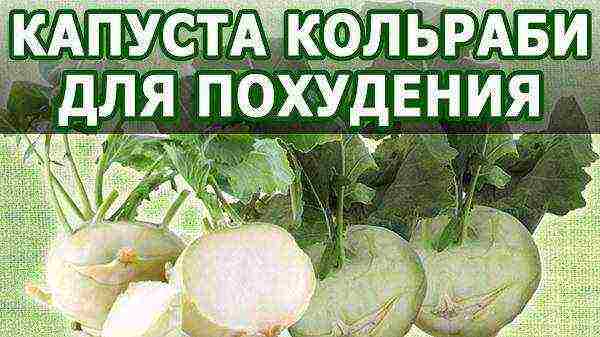 Kohlrabi for weight loss
Kohlrabi for weight loss
Growing from seeds
The cultivation of kohlrabi is carried out by sowing seeds in open ground and by the seedling method. In the middle zone of the Russian Federation, the latter method is recommended for obtaining an early harvest. Seedlings are grown at home in boxes or in greenhouses.
Seed sowing dates
Experts recommend three sowing dates. For an early harvest, seeds are sown for seedlings in the second decade of March. The crop is harvested in the first decade of June. In order for the crop to ripen at the end of July, seeds are sown for seedlings in early May. The third term - at the end of June, seeds are sown in open ground, harvesting at the beginning of October.
Sowing seeds and caring for seedlings
To obtain high-quality seedlings, pre-sowing preparation is carried out. The first stage consists in heat treatment in hot water for 10-15 minutes, followed by immersion in cold water. The second stage is to soak the seeds overnight in a solution with microelements. Third, after washing, the seeds are placed in the refrigerator for 24 hours. You need to wait for the seeds to bite in a damp cloth.
Further, individual containers or cassettes are filled with garden soil. Seeds are sown one at a time in a pot. This method eliminates the need for picking, which damages the root system of the seedlings. Crops are covered with foil. The temperature regime should be within + 20-22 degrees. After the emergence of seedlings, the film must be removed, and the temperature must be lowered to +10 degrees.After 12-14 days, set the temperature to + 16-20 degrees.
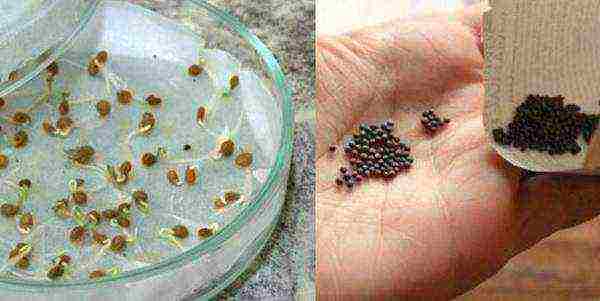 Kohlrabi seeds and germinated seeds
Kohlrabi seeds and germinated seeds
Seedling care consists of the following activities:
- maintain the required temperature in the room so that the seedlings do not stretch;
- to carry out prophylaxis against the "black leg" with a pink solution of potassium permanganate;
- to feed plants in the phase of two leaves with microelements and complex mineral fertilizer.
Picking
A pick is needed if the seeds were sown in a common container. Then it is necessary to plant the plants in the phase of one true leaf in peat pots.
Kohlrabi seedlings react negatively to a pick. It is better to grow them initially in separate containers!
For unpicked seedlings, the temperature is maintained at + 18 degrees during the day, + 10 at night. The hardening of plants should be carried out several days before planting in a permanent place. Since cold weather initiates the appearance of arrows, there is no need to rush to plant seedlings.
 Seedling picking
Seedling picking
How and when to plant seedlings in open ground
Sunny areas are chosen for the beds. The crop can also be grown as a sealant with other vegetables and herbs.
Soil for planting
Kohlrabi is not demanding on the composition of the soil, but tough fruits grow on acidic, unfertilized beds. In the fall, the site must be prepared for digging by introducing organic matter, ash, urea and superphosphate.
The amount of fertilizer applied will depend on the composition of the soil. Lime is added if necessary. In early spring, the soil is dug up, loosened. When digging, ammonium nitrate is added at 15 g per 1 m2.
It is necessary to follow the rules of crop rotation and plant plants in the beds where carrots, legumes, potatoes, tomatoes, and onions used to grow. It is not advisable to plant kohlrabi after cruciferous plants.
Boarding rules and times
For work, we choose a gloomy day or evening. It is possible to plant seedlings in open ground when the plant has 5-6 leaves. It is necessary to plant the bushes observing the distance between the rows of 60 cm, between the seedlings 25 cm.The distance is adjusted depending on the variety. It may be slightly less in early ripening varieties. Most kohlrabi varieties are early ripening, ripening 65 - 70 days. The late growing season is 120 days or more.
 Planting seedlings in open ground
Planting seedlings in open ground
When planting, the seedlings should not be deeply buried in the ground, because the formation of the stalk may be disrupted. After planting, the plants must be well watered and mulched.
At the same time, they are sowing seeds for seedlings of the second harvest, it will need to be planted in the second decade of June.
In open ground, kohlrabi seeds can be sown in early May. To harvest fresh cabbage fruits throughout the season, seeds are sown two more times with an interval of 20-30 days.
Sowing is carried out to a depth of 15-20 mm according to the 4 * 50 cm scheme. After the appearance of a real leaf, it is necessary to thin out the seedlings. Ultimately, the distance between plants should be at least 20 cm.
Outdoor kohlrabi care
Fruits are formed when the plant has 7-8 leaves. They gain mass quickly. Care in the beds consists in the timely weeding of weeds, loosening the row spacings and hilling the stems.
The main task of the gardener is to provide competent watering. The soil should always be moist. Water often, but in moderation. Only in this case the roots are juicy and tender.
During the growing season, root feeding should be carried out twice with complex fertilizer with microelements. If necessary, we do foliar spraying with a solution at the rate of 20 g of urea and potassium sulfate per bucket of water.
Protection from pests and diseases
Cruciferous plants are susceptible to disease and pests. Kohlrabi suffers from them somewhat less, but can be affected by bacteriosis, keel, powdery mildew, dry rot, mosaic, black leg. This will not happen if preventive measures are taken in time:
- observe agrotechnical rules of care;
- use tested and prepared seeds, with heating and disinfection with special preparations or potassium permanganate solution;
- remove and burn plant residues after harvesting with deep digging of the soil;
- systematically remove weeds;
- choose varieties with resistance to diseases.
There are quite a lot of insects, cabbage pests: cruciferous fleas, wireworms, scoops, slugs, bear, cabbage whites, aphids and others.
Prevention is also important here. In addition to the above measures, one of the main ones is the implementation of the rules for crop rotation.
In case of disease and insect damage, plants must be treated with fungicides and insecticides. Their assortment is wide enough on the modern market. However, the harm of chemicals is not in doubt. It is best to follow agricultural techniques and use harmless folk methods.
Harvesting and storage
Kohlrabi is a fairly cold-resistant culture. For winter storage, it is removed in late September, early October, when the temperature begins to drop to zero degrees. Harvesting takes place on a sunny day.
As you already know, three crops can be harvested during the garden season. The first two are collected selectively, preventing the overgrowth of cabbage over 8 cm. With a larger diameter and weight over 100 g, it coarsens and loses its taste. Shelf life 3 days under normal conditions, up to one month in a refrigerator.
In order to correctly ensure the winter storage of cabbage, we recall the following rules:
- the purple colors of the fruit are best for storage;
- root crops are pulled out, shaken off the ground or wiped with a rag, do not wash;
- the leaves are cut, leaving the tips of 15 mm;
- choose healthy, whole fruits for storage;
- placed in a cellar in boxes sprinkled with sand.
Optimal storage conditions are to maintain a humidity of 95% and a temperature between 0 degrees and +5.
Many gardeners are biased towards kohlrabi, considering it an overseas culture. However, when simple agrotechnical rules are followed, this type of cabbage grows well in the Russian dacha. Due to its composition and beneficial properties, kohlrabi will provide your family with the necessary vitamins and minerals for the whole winter!
The cultivation of kohlrabi cabbage requires compliance with certain agrotechnical rules, which consist in the correct preparation of the soil, planting, and caring for the plantings. Do not assume that kohlrabi cabbage care should be carried out only at the initial stages of plant development.
Since even if the growing conditions change slightly, it is fraught with a deterioration in the quality of the crop or even a complete loss of the crop. Therefore, it is worth listening to the advice and recommendations of experienced gardeners and vegetable growers who have adapted to growing kohlrabi cabbage, and create favorable conditions for it to grow.
Content
Key conditions for proper cultivation of kohlrabi for seedlings
To begin with, you should know that there are different varieties of cabbage - white cabbage, Peking cabbage, cauliflower. Kohlrabi cabbage is rarely grown in our regions. This is due to the fact that it is necessary to take great care of it, not like ordinary white cabbage.
And during landing, you also need to be more careful. Planting kohlrabi cabbage in open ground is not as easy as planting other varieties of garden crops. Even if you take care of it, as with ordinary cabbage seedlings, there are certain unfavorable factors that negatively affect the growth and development of the plant.
Before you start sowing cabbage seeds, you should remember about the correct preparation of the soil substrate, since this crop is too often negatively affected by unfavorable factors.
Also, one of the important factors is the optimal moisture content of the soil mixture, since a deviation from the norm in any direction can provoke negative consequences for the culture. It is also important to choose a site on which cabbage seeds will be planted in the future.
The site for the future planting of a garden crop should be located in a bright place, since kohlrabi is a very light-loving plant. It is also necessary to take into account which predecessors were previously located on the selected site.
It is not recommended to sow seed in the area where crops such as radishes, turnips, tomatoes, and beets were previously grown.
This is due to the presence of nutrients in the soil and the fact that these precursors suck out all these nutrient components, and after such precursors, various pathogens can remain in the soil, which are dangerous for kohlrabi.
It is recommended to plant this type of cabbage in the area where crops such as cucumbers, potatoes, and cereals were previously grown.
In addition, it is necessary to plant the planting material in neutral soil, since an acidic soil mixture is not favorable for sowing the material in open ground. If the soil is too acidic, liming should be carried out. Such a soil will be most favorable for sowing seeds or seedlings.
What care for planted seeds should be carried out
If you decide to use cabbage seeds for growing seedlings, all manipulations are directly related to which cabbage seeds should be used - purchased at specialized points of sale or collected with your own hands. If the sowing of the material that is collected by hand is carried out, such seeds must be carefully prepared.
To begin with, they should be immersed in hot water for a certain period of time. The seeds should be kept in such water for at least a quarter of an hour. Then they are taken out and immersed immediately in ice water.
Such a peculiar way of hardening the material will allow in the future to grow strong seedlings and get a good harvest. At the very end, they are dried, very good. After such manipulations, the planting material is ready for sowing.
If the material for planting is purchased at a specialized point of sale, there is no need to carry out any hardening, since the manufacturer has already taken care of the preliminary preparation of the seed material.
The hardening of the seeds collected with their own hands is carried out immediately before planting the seeds. Additionally, it is recommended to soak the seeds for 24 hours in cold water. Thanks to this hardening, the seeds germinate faster and become much more resistant to adverse factors during the growth and development of adult plantings.
In the future, such a culture will be resistant to frost, even at 5 degrees below zero, it will not die. But that culture that has not been pre-hardened can withstand no more than three degrees below zero.
For the correct growth of plants, it is recommended to pre-loosen the soil substrate, while simultaneously introducing a large amount of peat into it. You can carry out a pick by moving the plants into a separate container, or you can skip picking by simply planting the plants at certain intervals.
There are also certain rules on how to care for emerging seedlings. Cabbage requires compliance with the temperature regime, soil irrigation should be moderate, because if there is a lack of moisture in the soil, plants can slow down their growth and development, they can dry out altogether.
And if there is a large amount of moisture, oxygen stops flowing to the root system, and this is fraught with the development of putrefactive processes, the appearance of various pathogens.
It is also important to observe the light and temperature conditions. With too low light or high temperature indicators, young seedlings will begin to stretch, the same effect is observed if the plantings are too thickened.
It is also important to follow such care rules as systematic airing of the room if the seedlings are grown in closed structures. Do not be afraid that in the first 14 days there will be an excessively slow growth of the plant, and the first true leaves appear no earlier than three weeks later.
Landing rules
It is necessary to plant only strong bushes that have a dark green color; two pairs of real leaves should be located on it.
When planting, it is recommended to observe certain intervals between plantings. Pits are dug, keeping a distance of at least half a meter between each other. And the distance between rows should be at least 70 centimeters.
The wells must be irrigated before starting to plant seeds or seedlings. Also, a mandatory step is the introduction of fertilizing in the form of compost, mullein, rotted manure, diluted bird droppings.
Additional addition of earth is carried out, mixed with a small amount of wood ash. Irrigate the soil again. When planting, you should be careful not to accidentally fall asleep the growth point on the seedlings.
Watering and feeding rules while growing seedlings
When the seedlings are planted, proper care is also important. The irrigation regime should be observed, the soil should be irrigated at least twice a week, and if the weather is too hot, the number of irrigations is increased. When the seedlings grow a little, the number of waterings can be reduced to once every 7 days.
In addition to watering, it is important to observe certain preventive measures aimed at combating pests and diseases. If this happens, it is recommended to fight with purchased or folk fungicides and insecticides.
It is also important to apply fertilizers on time. The first feeding is carried out 14 days after transplanting. For this, phosphate fertilizers, mullein, diluted bird droppings are used.
The second top dressing is carried out another 14 days after the first fertilization. The same types of feeding are introduced. All further fertilization is applied as needed, depending on the saturation of the soil with nutrients.


